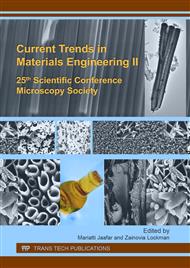p.91
p.95
p.99
p.103
p.107
p.112
p.116
p.120
p.124
The Influences of Chemical and Mechanical Treatment on the Morphology of Carbon Nanofibers
Abstract:
Oxidation by acid treatment is one of the chemical methods used to introduce surface oxygen functional group (SOFG) and defects on the surface of carbon nanofibers (CNFs). Therefore, many researchers used this method to improve the dispersion ability of CNFs in aqueous media. However, only few researchers used combination of chemical and mechanical method for oxidation of CNFs. In this work, as-received CNFs were treated using chemical method with an addition of mechanical method. On the first experiment (Method A) concentrated sulphuric acid and nitric acid were used and followed by combinations of mechanical method using ultrasonication water bath under reflux. The addition mechanical method through reflux was eliminated and different times of ultrasonication were used in method B and method C. Outer diameter of each CNFs samples were determined from FESEM images and were found to be in range of 50 nm–190 nm. Whereas, Raman spectroscopy was used to analyse any structural defects of CNFs samples during each treatment methods. From the findings, acid treatment of CNFs with addition of mechanical method using ultrasonication showed remarkably effect on the CNFs morphology.
Info:
Periodical:
Pages:
107-111
Citation:
Online since:
September 2017
Price:
Сopyright:
© 2017 Trans Tech Publications Ltd. All Rights Reserved
Share:
Citation:


